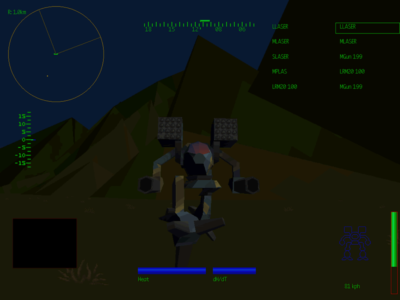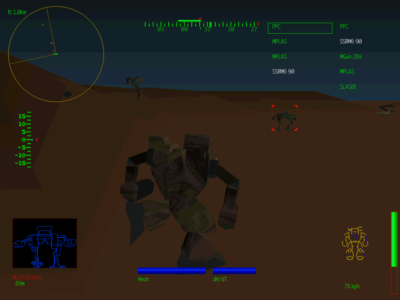
Mechwarrior 2
Written by: Stoo
Date posted: October 22, 2001
- Genre: Simulation
- Developed by: Activision
- Published by: Activision
- Year released: 1995
- Our score: 6
Mechwarrior 2 is based on the Battletech tabletop RPG which is apparently quite popular in the States. Myself, I’m afraid I really don’t know much about the background to the Battletech universe. For now suffice to say that in the far future, humanity is scattered across the galaxy and in some areas has fragmented into warlike clans. The preferred weapons are Battlemechs, huge war machines on legs that can be over fifteen metres tall. Currently two clans, Wolf and Jade Falcon are having a bit of a rumble, and you have the option to be a mech pilot for either.
I suppose some people (outside of the core Battletech audience) may have expected Mech2 to be Doom with giant robots, and thus got put off by the fairly complex controls. This isn’t a shoot’em up but rather a simulation game, and driving these things does take a little getting used to. Instead of hitting a key to walk forwards, you actually have a throttle control. Meanwhile, most mech’s upper bodies can pivot about the waist, and also tilt up or down. In short the direction you’re looking and firing in, and the direction in which your huge war machine is stomping at 80 kilometres an hour, are often quite different. You do therefore need to keep an eye on where you’re going, and try not to run into a wall whilst training your gunsights on an enemy mech. You mouse would seem like the obvious choice for controlling aiming, unfortunately using it the turret feels quite heavy and sluggish. Accurate aiming can thus be quite tricky, especially in a moment of crisis.
Before actually starting a mission, you get to choose your walking instrument of death. The mechs range from relatively tiny 25 ton scouts to immense 100 ton bruisers. Obviously enough, the little ones are fairly fragile but can run like hell, whilst the big bastards are heavily armoured but fairly sluggish. Of course, a bigger mech also has more space to stack your weapons of destruction, including lasers, missiles and heavy cannon. Each mech comes with several pre-set weaponry layouts, or you can have a go at configuring it yourself.
This tinkering with the mech’s innards goes into a lot of detail, you’ll find it tedious or absorbing depending on personal preference. Your mech is divided into arms, legs, head and three body sections, each with a number of hardpoints to attach things. Apart from guns you also have to worry about ammunition, heat sinks (to dissipate heat built up from firing weapons), armour and an engine. The only limits to how you can arrange stuff are number of hardpoints, and tonnage limit, and it’s quite possible that your final layout will bear no resemblance to the external appearance of the mech. There’s enough potential fiddling here to keep those who like that kind of thing busy for hours. I would recommend though that if you’re not familiar with the Mech games, you stick at first to the existing designs to get a feel for how the mechs and their weapons handle.
Note however that unlike the later Mechwarrior games there is no kind of resource management in this one. At the start of each mission you can pick any mech with any weapons that you wish, and regardless of how smashed up it is by the end, you’ll have a shiny new one to play with at the start of the next mission.
One you’re geared up, it’s time to take you’re walking tank into battle. The Mech-on-mech combat still has much playability today. The first few times you play you’ll probably just walk at the enemy, guns blazing, but as you get the hang of the controls and weapon systems you see there is some scope for more imaginative tactics. You can try circling and harassing the enemy with a fast mech, or sit back with a payload of long-range missiles. Mech2 uses a proper locational damage system, so you can happily blast a mech’s arm off, taking any weapons mounted there with it. Alternatively, hammering directly at the body will hopefully knacker heat sinks, detonate ammo and so on. (One small glitch here – a mech can continue to stand and fight on one leg, often in an impossible act of balance.) The concept of heat management also plays a part in your tactics; if you fire blindly for extended periods of time you risk overheating and blowing up, so it pays to take your shots carefully rather than hosing the enemy down with laser-fire.
Of course when a game involves huge robots wandering around annihilating things you’d want it to look good. The Mechs themselves are still reasonably convincing, and do retain an impression of size and general presence. It’s still possible to believe that these are monstrous war machines stomping across the land, quite capable of stamping on people in addidas tracksuits or kicking over ice-cream vans. However, compared to modern big-robot games they do move rather stiffly and are lacking in detail. The terrain meanwhile looks very dated, consisting of a flat plane with the odd embankment or jagged hill dropped on top. Once or twice we do see a number of polygon-hills joined together to produce a semblance of rough terrain, but then it’s back to running around on top of a giant snooker table. In short, even though Mech2 did see enhancements from the first generation of 3D cards, its aged nature deos stand out in comparison to later games of this type. On a more positive note, though, this one of the first simulations to feature a “virtual cockpit”, allowing you to look around freely from the driving seat rather than having fixed “up, down, left, right” views.
The layout of the game meanwhile is entirely linear, with a series of missions for either side. Each mission is presented with a large dollop of background waffle about the war between the clans and to be honest this plot material is pretty dull and largely forgettable. There’s also a lot of talk about “honourable” warriors and the glory of the clans, etc etc, which personally I think should be left to the Klingons. Of course, you can happily play the game whilst ignoring all this guff and sticking to reading mission objectives, but the lack of a decent story can in the long term make the missions a slightly soulless experience. At least though there’s plenty of destruction to keep you entertained for a while. You’re usually out to flatten some enemy installation whilst taking out enemy mechs in the area. Occasionally there is some variation, such as defending a friendly train, or running like hell from a soon-to-blow reactor.
Overall, if you can cope with slightly clumsy controls then Mechwarrior can be quite rewarding to play. However, you will have inevitably skipped ahead and found the adequate but not amazing score of 3/5. Why not more? When establishing this site, a fundamental directive was that we would not over-rate games that have aged and been surpassed. In all fairness modern big-robot games have eclipsed Mech2, especially its own sequels. Mechwarrior 3, which is itself a few years old now, is in just about every way superior to Mech2. Then again if you’re a serious fan of the “big robot” games and interested in haven’t yet encountered this old warhorse of the genre, or are just running an ancient computer, Mech2 is still worth a look.




 Posts
Posts